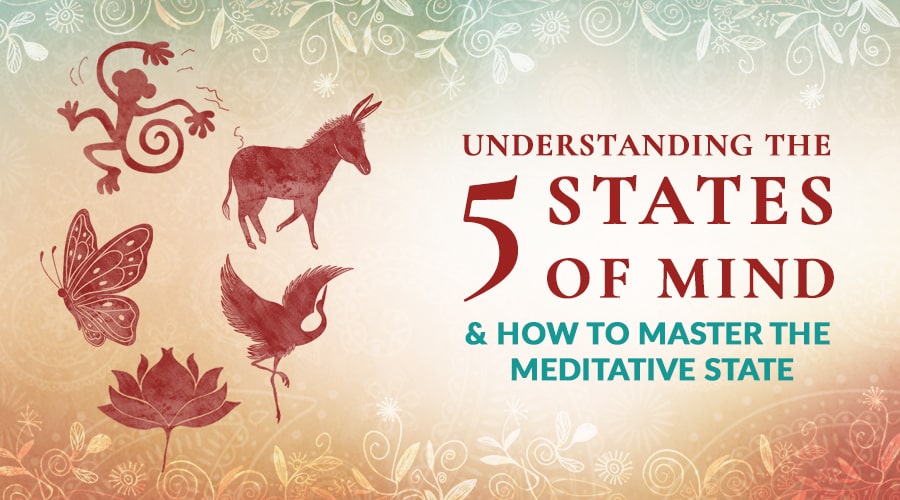When we think of a meditative state, a serene guru sitting in perfect calm and control typically comes to mind. Legs crossed in Lotus Pose, spine tall, and eyes gently closed. But if you've ever attempted meditation for more than a few minutes, you know that it's not as simple as it appears.
Many of the students who join my meditation course want to know the secret to the yogi mind and how they can access a higher level of awareness. However, to understand that, we first need to understand Patanjali’s 5 states of mind.
Read on to discover the five states of consciousness in yoga and how you can transcend each and experience inner peace and pure bliss.
What Is a Meditative State?

In yoga, a meditative state is defined as a state of heightened awareness, deep concentration, and inner stillness. In this state, you become disconnected from external illusions and aware of the silent observer, the Self.
The constant chatter of the mind quietens, and you experience a profound sense of calmness. Your body relaxes deeply, releasing any tension or stress, and you can observe your thoughts and emotions with complete clarity and non-judgment.
When you enter this dimension of the higher mind, you are also able to explore the deeper truths of who you are. This can lead you to the center of your being, where the super-consciousness or “the Self” lives.
What Does Patanjali's Yoga Sutras Say About It?
Patanjali's Yoga Sutras offer profound insights into the meditative state and how to master it. As Patanjali wrote in the Yoga Sutras (verse 1, 2), "yogash chittavrttinirodha," which translates to "yoga stops the fluctuations of the mind."
Whether in meditation practice or an important work meeting, all of us experience how “vrtti” (movements or fluctuations) disrupt the “chitta” (conscious mind) and hamper our ability to find inner calm and clarity.
However, Patanjali offers a path to the true yogi mind by identifying 5 states of mind or consciousness, known as “chitta bhumis” in Sanskrit. While each stage of consciousness will vary depending on the practitioner, he explains that we can group them into 5 states of mind. These are:
- Kshipta
- Mudha
- Vikshipta
- Ekagra
- Niruddha
Understanding the yoga’s five states of consciousness is the first step conquering them. Patanjali reveals that through yogic practices, we can transcend the limitations of the mind and progress towards the ultimate state, samadhi.
Samadhi represents the pinnacle of Patanjali's Eight Limbs of Yoga. It is a state where you connect deeply with your innermost Self, experiencing a profound sense of unity, clarity, and bliss.
Yet to reach a higher dimension of the Self, we must understand the 5 states of mind.
Yoga’s 5 States of Mind Explained
1. Kshipta: Monkey Mind

The first yogic state of consciousness is Kshipta, or monkey mind. In this state, the mind is restless, constantly shifting from one thought or emotion to another, making it difficult to focus or find inner calm.
If you are in the scattered Kshipta state, you are easily distracted by external and internal influences and lack stability and clarity. Completing simple activities becomes impossible, and your decisions lack direction as you jump from one impulse to the next.
Meditation and relaxing yoga practices like Yoga Nidra are known to calm the waves of thoughts, helping you transcend the Kshipta mind and access a more conscious state.

Get your free copy of the how to find the most comfortable sitting position for meditation Ebook
2. Mudha: Donkey Mind

The second state, Mudha, is characterized by dullness and laziness like a donkey's mind. We typically find ourselves in either the Kshipta or Mudha state, with mental fatigue and lack of clarity common symptoms of this state. Other symptoms include sadness, depression, hopelessness, poor concentration, and a lack of purpose in life.
Overcoming the dull Mudha mind requires a conscious effort to awaken the mind and infuse it with energy. Mindfulness meditation or concentration meditation with a mudra or mantra can increase your awareness and provide you with the energy you need to transcend this stage.
3. Vikshipta: Butterfly Mind

Vikshipta is the third state of mind and can be described as a distracted or butterfly mind. In this state, the mind is sometimes focused but quickly pulled in different directions, like a restless butterfly jumping from one flower to another.
Although Vikshipta is more focused than Mudha or Kshipta, the moments of clarity are fragmented and the mind experiences only momentary stillness. As a result, butterfly mind is a common obstacle in deep concentration and meditation, preventing the mind from settling into inner silence.
Regular meditation and yoga can help deepen your focus and decrease the number of distractions you experience in this state. Moreover, it trains the mind to relax, helping you lengthen the time of focus and find peace in moments of unrest.
4. Ekagra: Crane Mind

Ekagra is the fourth state of mind, and can be described as a single-pointed mind or a crane mind. In this state, the mind becomes one-pointed, undistracted by external influences. It is a state of heightened concentration and absorption, where the mind fully engages with the present moment.
The focused Ekagra mind allows for deep contemplation and introspection, making it a powerful tool for self-realization and spiritual growth. Sitting in meditation deepens our concentration, helping us reach the next state of mind.
5. Niruddha: Mastered Mind

After moving past the Ekagra, you enter the fifth yoga state of mind, Niruddha. This is the mastered mind or a yogi mind. In this state, your mind is completely still and no longer agitated or disturbed by external or internal factors.
The mastered Niruddha mind represents a state of pure calmness we experience in meditation, where you are completely absorbed into the present moment. Here, the mind is free from all attachments and desires, and you begin to experience deep peace and bliss. Yogis who can access this state and sustain it will eventually reach samadhi.
Final Thought
In the journey of self-discovery and spiritual growth, Patanjali's teachings on the 5 states of mind in yoga hold real significance. The chitta bhumis serve as a guiding light, illuminating the path towards stillness and self-awareness. By understanding these yogic states of consciousness— Kshipta (distracted), Mudha (dull), Vikshipta (partially focused), Ekagra (one-pointed), and Niruddha (completely controlled) — we learn how to transcend the limitations of the human mind and access profound insight, inner peace, and in the end, our true selves.

Get your free copy of the how to find the most comfortable sitting position for meditation Ebook

